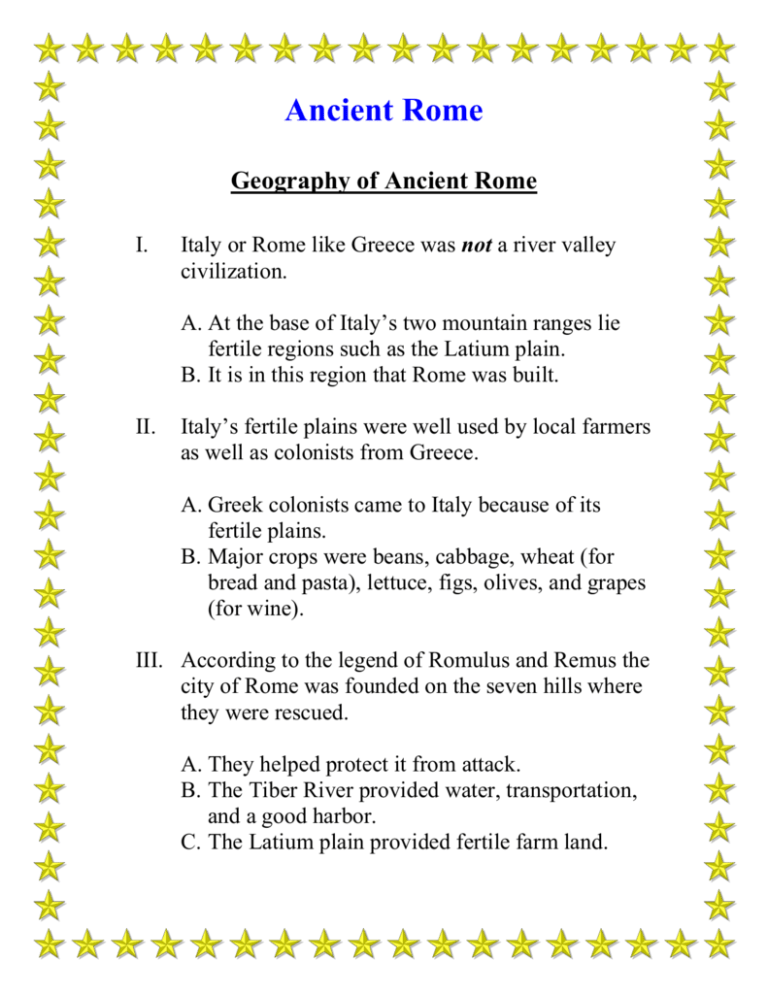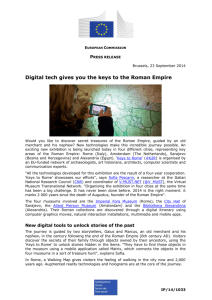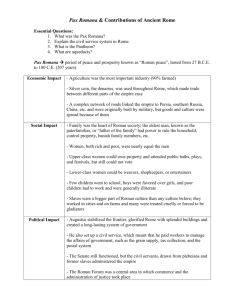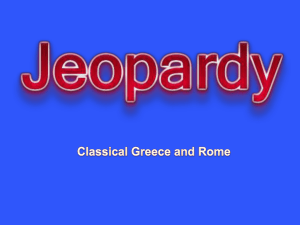Ancient Rome Class Notes
advertisement

Ancient Rome Geography of Ancient Rome I. Italy or Rome like Greece was not a river valley civilization. A. At the base of Italy’s two mountain ranges lie fertile regions such as the Latium plain. B. It is in this region that Rome was built. II. Italy’s fertile plains were well used by local farmers as well as colonists from Greece. A. Greek colonists came to Italy because of its fertile plains. B. Major crops were beans, cabbage, wheat (for bread and pasta), lettuce, figs, olives, and grapes (for wine). III. According to the legend of Romulus and Remus the city of Rome was founded on the seven hills where they were rescued. A. They helped protect it from attack. B. The Tiber River provided water, transportation, and a good harbor. C. The Latium plain provided fertile farm land. IV. Etruscan Kings ruled Rome and other regions of Italy until 509 B.C. A. 509 B.C. the nobles (wealthy land owners) over threw Traquinius and formed the Roman Republic. The Rise of the Roman Republic I. After 509 B.C. Rome’s wealthy citizens over threw the Etruscan Kings and created a republic in which citizens elected leaders to govern them. A. Roman nobles over threw the last of the Etruscan Kings, Tarquinius takes control of the government. B. The Patricians (wealthy land owners) or nobles had most of the power. C. The Plebeian’s (common citizens) had little or no power in the government. II. After the threat of a Plebeian Revolt, the Republic of Rome was divided into main branches: the Consul, Senate, Tribunes, and the Citizens Assembly. A. The Consul is one of the elected officials of the Roman Republic who commanded the army and were supreme judges. B. The Senate is the most oldest and powerful branch of the republic. The Senate was controlled by Rome’s Patricians. 1. Determined how Rome would act toward other countries. 2. Controlled all money and collected taxes. C. Tribunes made up of plebeians they protected plebeian’s rights and had veto power over consuls’ laws. 1. Protected plebeians instrumental in establishing the Twelve Tables (Rome’s written code of laws). D. Citizens Assembly- formed by the plebeians, they elected tribunes who worked to gain rights for plebeians. Tribunes were the leaders of the Assembly. 1. Tribunes bought plebeian complaints before the Senate and Consuls. 2. Assembly elected Consuls (patricians) to 1 year terms. 3. Could veto or stop any consuls’ actions. III. The defeat of Carthage in the Punic War made Rome the leading power in the Mediterranean region by 202 B.C. The Roman Empire I. In 45 B.C., Julius Caesar takes control of Rome and declares himself dictator. A) As dictator, Caesar makes many important changes to life in Rome. B) He changes the way time is measured and creates the basis for the calendar we used today. C) Caesar also gives land to his soldiers and free grain to poor citizens. D) He increased the number of people who could serve in the Senate and he grants Roman Citizenship to many people born in Rome. II. These actions cause some Senators (Patricians), to become very angry with Caesar. They think he is reducing their power. A) On March 15th 44 B.C. Caesar is killed by his enemies as he enters the Senate. B) After Caesar’s death, Rome is thrown into a civil war. III. By 27 B.C. Octavian (Caesar’s adopted son), had defeated many of Rome’s must experienced generals. A) These victories cleared the way for Octavian to become dictator. B) Octavian took the name of Augustus or “Honored One”. C) This singled the beginning of the Pax Romana or 200 years of peace. IV. It was during the Pax Romana that the Roman Empire goes through its “GOLDEN AGE”. A) Rome begins to use a single system of government and money. B) Many public work projects are started: 1) Roads throughout the empire - a majority leading to Rome 2) Aqueducts to bring fresh water to the cities and many grand buildings and temples. C) Police and fire departments were also formed. V. Roman religion shared many similarities with that of Ancient Greece. A) Both were polytheistic – belief in many gods. B) Romans worshiped Egyptian and Persian gods and goddesses as well. Beginnings of Christianity I. Christianity developed in Roman occupied Judea during the Pax Romana. A) The story of the birth is told in a collection of books called the New Testament. B) The Old and New Testament form the Christian Bible. C) The life and teachings of Jesus are recorded in the New Testament of the Christian Bible. D) The New Testament says that the followers of Jesus believed that he was the Messiah. E) Two of Jesus’ followers, Peter and Paul, helped to spread Christianity throughout the Roman world. The Decline of The Roman Empire I. Invasions, tax collection problems and other factors weakened the Roman Empire in the A.D. 200’s A) These invasions bring to an end the Pax Romana. B) The invaders from Northern Germany were attacking an empire that had gotten to big to control. II. In about 284 A.D., Diocletian divided the Roman Empire into two parts – Western and Eastern. A) This made it easier to rule the empire. B) Three assistants ruled the western empire while Diocletian took control of the eastern empire – Greece, Egypt, and Palestine. III. Constantine established the Byzantine Empire in the east. A) He stops persecution of the Christians and becomes Christian himself. B) He gives money to help build Christian Churches and Christianity gains more power – it becomes the religion of the Roman Empire. C) Appoints Christians to important government posts. D) Result Roman Catholic in Rome and Eastern Orthodox in the East. IV. In A.D. 410, Western Empire collapses with the fall of Rome. While the eastern empire continued to live on. A) After the fall of the Western Empire, the Eastern Empire lives on for another 1,000 years. B) It became known as the Byzantine Empire 1. This was in honor to the Greek city of Byzantium. 2. Many Greek and Asian influences – people started to speak Greek not Latin. V. Rome left us many legacies of government language, arts, and architecture. 1. They also helped spread Christianity to the world.









